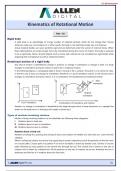Class notes
Good quality notes on Physics - Kinematics of Rotational Motion. Very helpful for students preparing for Engineering and medical entrance examination and also who are studying in Class XI and XII
- Course
- Institution
Good quality notes on Physics - Kinematics of rotational Motion. Very helpful for students preparing for Engineering and medical entrance examination and also who are studying in Class XI and XII
[Show more]



